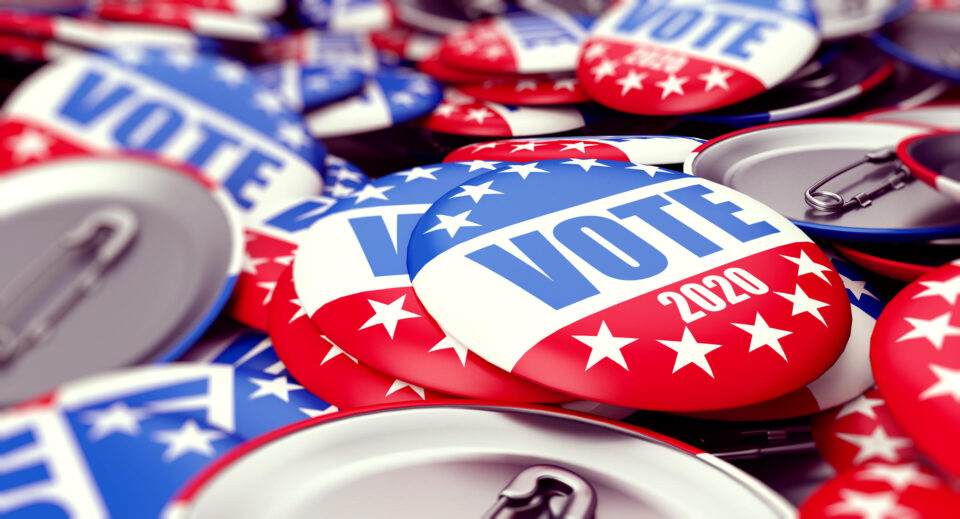

Biden has gambled by forgoing face-to-face organizing due to the pandemic, relying instead on a virtual campaign to get out the vote. Our new study suggests his gamble will pay off.
This election’s candidates have fielded two very different campaigns—one face-to-face, the other socially distanced. Donald Trump’s campaign has continued canvassing door-to-door and holding in-person rallies throughout the election cycle. Meanwhile, Joe Biden’s campaign, citing safety concerns because of the pandemic, has been almost entirely virtual.
Can virtual forms of organizing compensate for a lack of face-to-face activities? Our new study suggests yes. We found that users of Outvote, a mobile app that helps you text personal contacts reminders to vote, had an 8 percentage point effect on getting their friends to cast ballots in the 2018 midterm elections. This effect is among the largest reported in the “get-out-the-vote” literature and is squarely within the range of effects previously measured for door-to-door canvassing, around 6 percentage points.
Biden’s embrace of virtual organizing centers around the Vote Joe app, listed first among suggested activities on the campaign’s volunteer website, is modeled after Outvote. Users create a queue of contacts to text voting reminders. The app helps you choose which friends to text by providing you with public information about them from the voter rolls, like whether they are registered in a battleground state, which party they are registered with, and whether in previous elections they were a “super voter” or an “infrequent voter.” Once you have created a queue, the app provides a default message for each contact, such as—”Hey! The election’s coming up. Are you voting by mail this year?”—which you can edit or send as is.
Our study suggests that get-out-the-vote texts from friends are fundamentally different from mass texts, like the one I received this morning from an unknown number: “Hey Aaron, it’s Kamala. I just have one question to ask you: Are you with me?” Meaning no disrespect, I ignored and deleted her message, along with three others like it. Mass texts are ineffective: meta-analysis estimates that they increase voter turnout by only half a percentage point.
Generally speaking, the theory that has emerged from two decades of field experiments on get-out-the-vote tactics is that only the more personal approaches substantially increase voter turnout. This is the reason campaigns have traditionally preferred face-to-face strategies to virtual ones, and why Biden’s decision to run a purely virtual campaign is understood as a gamble.
Biden is betting that having virtual messages delivered by trusted messengers, like family members, colleagues, or friends, will imbue messages with enough of a personal touch to make them a viable alternative to face-to-face. Our study paints a hopeful picture for Biden’s bet.
Some caveats are in order. Ours is a single study, and there have been few other studies of friend-to-friend tactics, mainly because they are tricky to study experimentally. If a study is too obtrusive, such that it hampers natural conversation, it may end up measuring the effect of friend-to-friend interactions that are stilted and inauthentic. And if the intervention is too weak, the study may fail to estimate effects with precision. Our study implemented a “light-touch” design, which injected just enough randomness into the app to identify effects, but not enough to hinder its users.
Moreover, it is an open question as to whether campaigns can wield friend-to-friend tactics as effectively as traditional ones to target specific voters. Imagine wanting to reach potential voters in Rural Valley, Pennsylvania, a town with a population of 800, in a state that might decide the election. Using traditional tactics, like phone-banking, a campaign can simply direct volunteers to call the numbers on their contact list. To employ friend-to-friend tactics, however, a campaign must already have willing volunteers who are friends with the voters of Rural Valley. It is possible that large swaths of the electorate are not in any Vote Joe user’s phone and thus out-of-reach of the Biden campaign’s friend-to-friend tactics.
The largest ever flurry of app-based get-out-the-vote activity will likely happen over the next few days. We will see whether Biden’s gamble pays off. If it does, expect future campaigns to go virtual, even after safety no longer dictates social distance.
Aaron Schein is a postdoctoral fellow at Columbia University’s Data Science Institute. The study’s senior co-authors are Donald P. Green, Burgess Professor of Political Science, and David M. Blei, professor of statistics and computer science, both at Columbia. Schein is on Twitter: @AaronSchein.
This brief originally appeared on Columbia News.